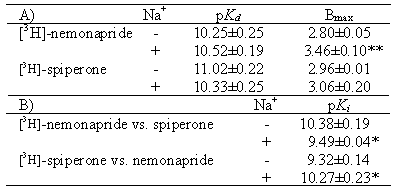| pA2
online © Copyright 2003 The British Pharmacological Society |
069P
University of Surrey Summer Meeting June 2003 |
|
Effect of
sodium ions on a ligand binding to the
|
Print abstract Search PubMed for: |
Dopamine receptor
ligands have been shown to exhibit different profiles of binding depending
on the assay conditions. Sodium ions lead to modifications in the binding
properties of antagonists such as raclopride (Armstrong et al.,
2001) or sulpiride (Freedman et al., 1982). The aim of this study
was to determine the influence of Na+
ions on the binding properties of [3H]-nemonapride
and [3H]-spiperone to the short isoform
of D2 dopamine receptor (D2S) expressed
in Sf9 insect cells.
Sf9 membranes were prepared from cells grown and infected as described
previously (Gazi et al., 2003). The binding assays were performed
incubating 20 µg of membranes in assay buffer (20 mM HEPES, 1mM
EDTA and 1 mM EGTA; pH 7.4 with KOH), with or without the presence of
100 mM NaCl, in a final volume of 1 ml at 25°C for 3h. (+)-butaclamol
(3µM) was used to determine the non-specific binding. In saturation
experiments radioligand concentrations were from 0.05 nM to 4 nM. In competition
experiments [3H]-spiperone (0.3 nM) and
[3H]-nemonapride (0.8 nM) and a range
of non-radioactive ligand from 0.1 mM to 1 fM were used. Data are mean±s.e.mean
for 3 or 4 independent experiments performed as triplicates and statistical
comparisons were made by Student's unpaired t-test (p<0.05).
Saturation binding assays were performed under different ionic conditions.
The Bmax for [3H]-nemonapride
increased by 25% with the addition of Na+
ions. Kd was not statistically
different in both cases. Bmax and Kd
values for [3H]-spiperone were not altered
by the change in ionic conditions (Table 1).
Competition experiments were also performed in the presence and absence
of 100 mM NaCl. The pKi of nemonapride
(vs. [3H]-spiperone) was reduced in absence
of Na+, while spiperone (vs. [3H]-nemonapride)
displayed a decrease in pKi
in presence of Na+ (Table 1).
The differences observed in the Bmax
in the saturation experiments together with the variations of the affinity
in the competition assays suggest a competitor concentration and Na+-dependent
negative cooperativity between the two ligands that does not fit with
the standard ternary complex model.

Table 1. Saturation
(A) and competition (B) analyses with [3H]-nemonapride
or [3H]-spiperone in the presence or
absence of Na+. (*p<0.05;**p<0.005,
for effect of Na+).
Armstrong, D. et al. (2001). J. Biol. Chem., 276,
2621-9.
Freedman, S.B. et al. (1982). J. Neurochem., 38,
1459-65.
Gazi, L et al. (2003). Br. J. Pharmacol., 138, 775-86.
We thank the BBSRC for financial support.